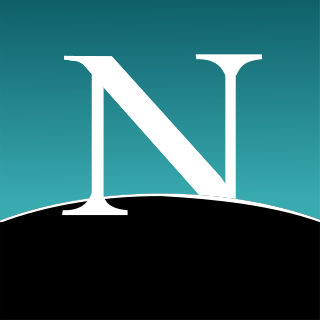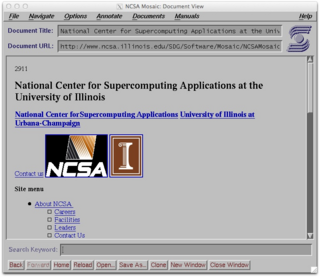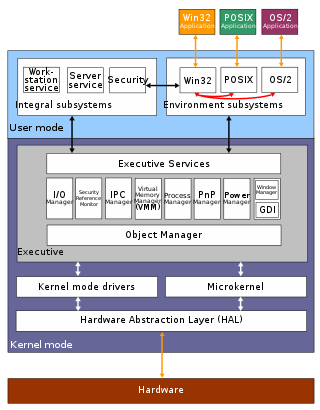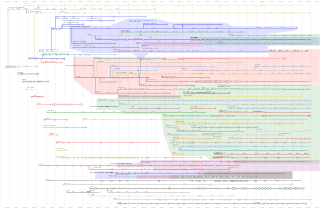
Internet Explorer is a retired series of graphical web browsers developed by Microsoft that were used in the Windows line of operating systems. While IE has been discontinued on most Windows editions, it remains supported on certain editions of Windows, such as Windows 10 LTSB/LTSC. Starting in 1995, it was first released as part of the add-on package Plus! for Windows 95 that year. Later versions were available as free downloads or in-service packs and included in the original equipment manufacturer (OEM) service releases of Windows 95 and later versions of Windows. Microsoft spent over US$100 million per year on Internet Explorer in the late 1990s, with over 1,000 people involved in the project by 1999. New feature development for the browser was discontinued in 2016 and ended support on June 15, 2022 for Windows 10 Semi-Annual Channel (SAC), in favor of its successor, Microsoft Edge.

Netscape Navigator is a discontinued proprietary web browser, and the original browser of the Netscape line, from versions 1 to 4.08, and 9.x. It was the flagship product of the Netscape Communications Corporation and was the dominant web browser in terms of usage share in the 1990s, but by around 2003 its user base had all but disappeared. This was partly because the Netscape Corporation did not sustain Netscape Navigator's technical innovation in the late 1990s.

NCSA Mosaic was among the first widely available web browsers, instrumental in popularizing the World Wide Web and the general Internet by integrating multimedia such as text and graphics. Mosaic was the first browser to display images inline with text.

The Windows API, informally WinAPI, is the foundational application programming interface (API) that allows a computer program to access the features of the Microsoft Windows operating system in which the program is running. Programs access API functionality via dynamic-link library (DLL) technology.

A browser war is a competition for dominance in the usage share of web browsers. The "first browser war" (1995–2001) consisted of Internet Explorer and Netscape Navigator, and the "second browser war" (2004-2017) between Internet Explorer, Firefox, and Google Chrome.
In computing, the User-Agent header is an HTTP header intended to identify the user agent responsible for making a given HTTP request. Whereas the character sequence User-Agent comprises the name of the header itself, the header value that a given user agent uses to identify itself is colloquially known as its user agent string. The user agent for the operator of a computer used to access the Web has encoded within the rules that govern its behavior the knowledge of how to negotiate its half of a request-response transaction; the user agent thus plays the role of the client in a client–server system. Often considered useful in networks is the ability to identify and distinguish the software facilitating a network session. For this reason, the User-Agent HTTP header exists to identify the client software to the responding server.
This is a comparison of both historical and current web browsers based on developer, engine, platform(s), releases, license, and cost.
Video for Windows was a suite of video-playing and editing software introduced by Microsoft in 1992. A runtime version for viewing videos only was made available as a free add-on to Windows 3.1, which then became an integral component of Windows 95. Video for Windows was mostly replaced by the July 1996 release of ActiveMovie, later known as DirectShow. Apple filed a lawsuit in 1994 alleging theft of several thousand lines of QuickTime source code to improve the software. The case was settled in 1997, when Apple agreed to make Internet Explorer the default browser over Netscape, and in exchange, Microsoft agreed to continue developing Microsoft Office and other software for Mac OS for the next 5 years, and purchase $150 million of non-voting Apple stock.

AOLpress is a discontinued HTML editor that was available from America Online (AOL). It was originally developed as NaviPress by the company NaviSoft before being bought by AOL. It was discontinued in 2000. However, the last version (2.0) may still be found on some Web sites for downloading.

IBM WebExplorer was an early web browser designed at IBM facilities in the Research Triangle Park for OS/2.
In the context of a web browser, a frame is a part of a web page or browser window which displays content independent of its container, with the ability to load content independently. The HTML or media elements in a frame may come from a web site distinct from the site providing the enclosing content. This practice, known as framing, is today often regarded as a violation of same-origin policy.

Microsoft Internet Explorer 3 (IE3) is the third version of the Internet Explorer graphical web browser which was announced in March 1996, and was released on August 13, 1996 by Microsoft for Microsoft Windows and on January 8, 1997 for Apple Mac OS. It began serious competition against Netscape Navigator in the first Browser war. It was Microsoft's first browser release with a major internal development component. It was the first more widely used version of Internet Explorer, although it did not surpass Netscape or become the browser with the most market share. During its tenure, IE market share went from roughly 3–9% in early 1996 to 20–30% by the end of 1997. In September 1997 it was superseded by Microsoft Internet Explorer 4.

Microsoft Internet Explorer 2 (IE2) is the second, and by now discontinued, version of Internet Explorer (IE), a graphical web browser by Microsoft. It was unveiled in October 1995, and was released on November 27, 1995, for Microsoft Windows, and on April 23, 1996, for Apple Macintosh.

Sausage Software was an Australian software company, founded by entrepreneur Steve Outtrim, which produced one of the world's most successful web editors: the HotDog web authoring tool. The product and company name have since been purchased by an Australian consulting firm, SMS Management & Technology.
A web browser is a software application for retrieving, presenting and traversing information resources on the World Wide Web. It further provides for the capture or input of information which may be returned to the presenting system, then stored or processed as necessary. The method of accessing a particular page or content is achieved by entering its address, known as a Uniform Resource Identifier or URI. This may be a web page, image, video, or other piece of content. Hyperlinks present in resources enable users easily to navigate their browsers to related resources. A web browser can also be defined as an application software or program designed to enable users to access, retrieve and view documents and other resources on the Internet.
In computing on Microsoft platforms, WoW64 is a subsystem of the Windows operating system capable of running 32-bit applications on 64-bit Windows. It is included in all 64-bit versions of Windows, except in Windows Server Server Core where it is an optional component, and Windows Nano Server where it is not included. WoW64 aims to take care of many of the differences between 32-bit Windows and 64-bit Windows, particularly involving structural changes to Windows itself.

UdiWWW is an early, now discontinued freeware graphical HTML 3.2 web browser for 16-bit and 32-bit Microsoft Windows. It was written and developed by Bernd Richter in C/C++ from 1995 to 1996. Following the release of version 1.2 in April 1996, Richter ceased development, stating "let Microsoft with the ActiveX Development Kit do the rest."

Frame-IT! was an application for developing HTML frames released in 1996 by GME Systems. It featured a user interface in which you could control frame size, the number of frames, frame location, and frame appearance without knowledge of HTML. It allowed completed frames to be copied to clipboard, to be saved, or to be previewed in a browser.
Egor was an early computer animation program for making animations in Java released by Sausage Software on February 6, 1996, as the first commercial Java applet. The software allowed for the creation of animated graphics with sounds to be deployed as a java applet for use through a web browser. Egor featured a user-friendly interface, tutorials, and sample images and designed for use by non programmers with minimal knowledge of HTML. The software is named after Igor, the mad scientist.









